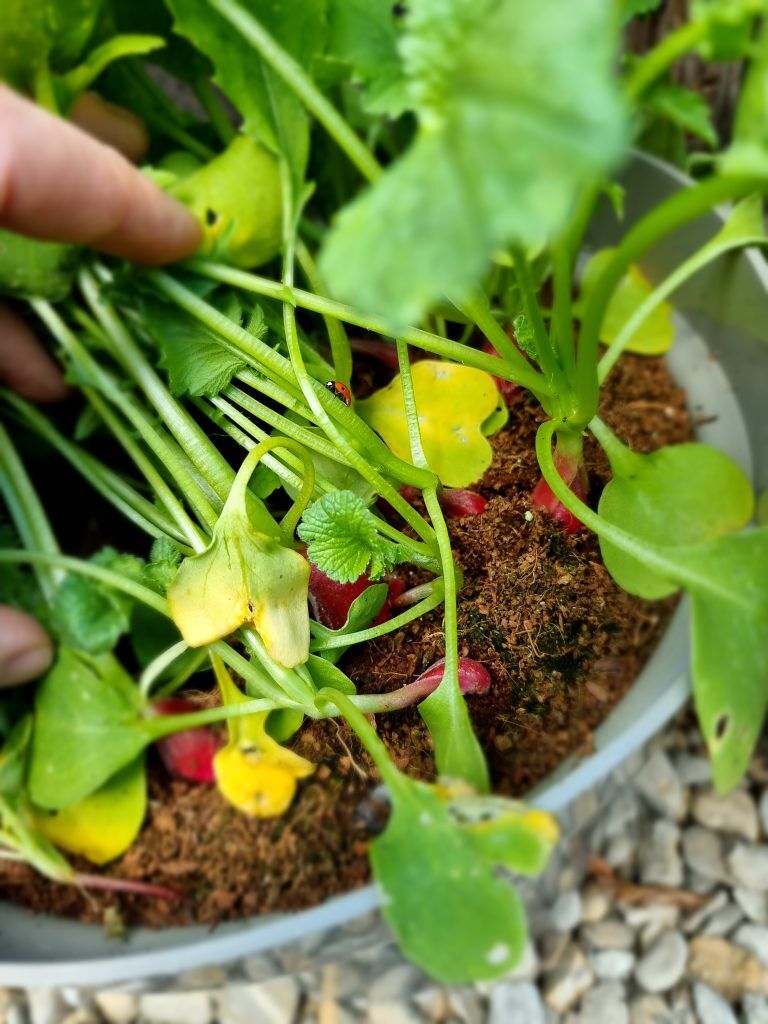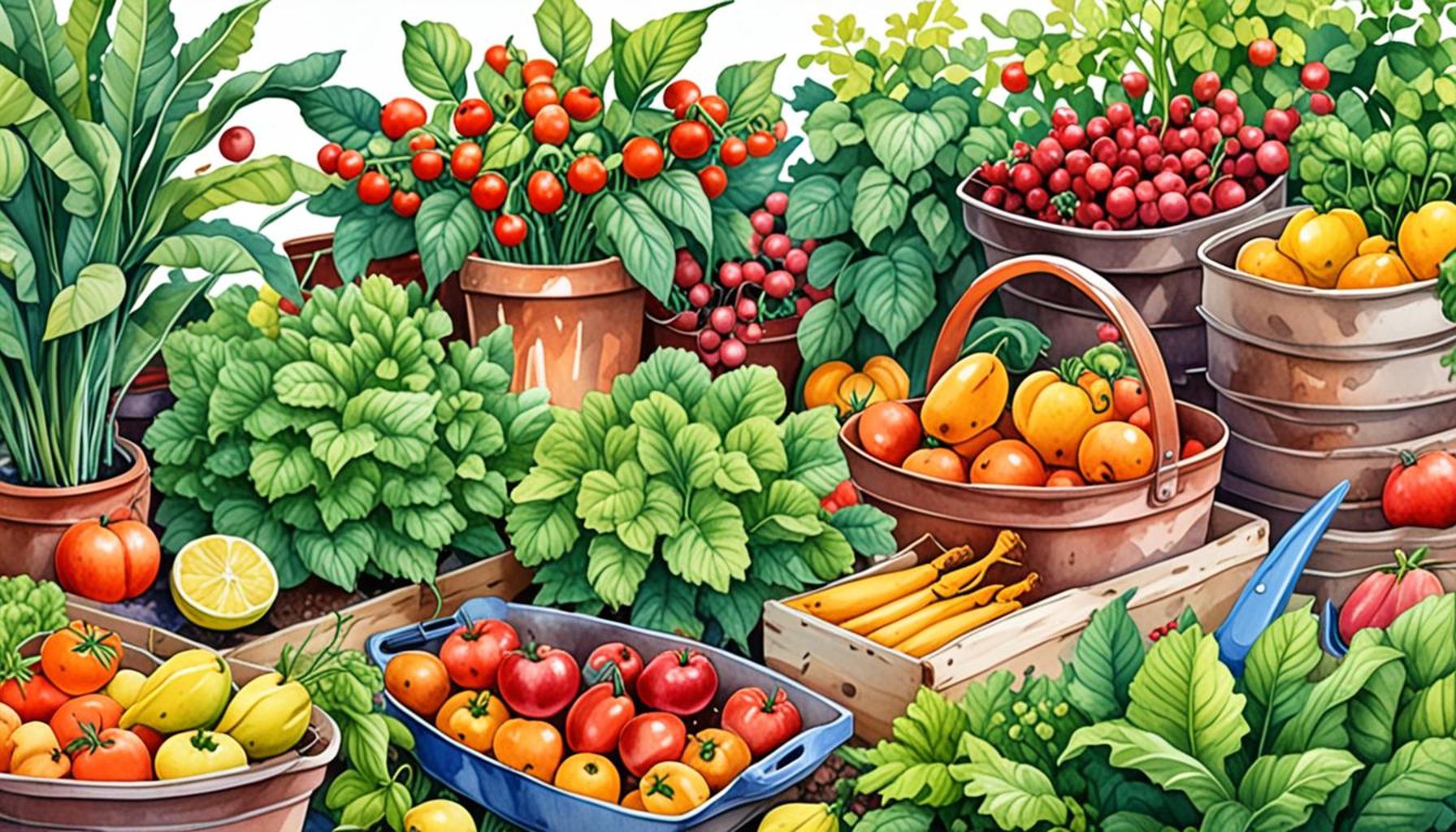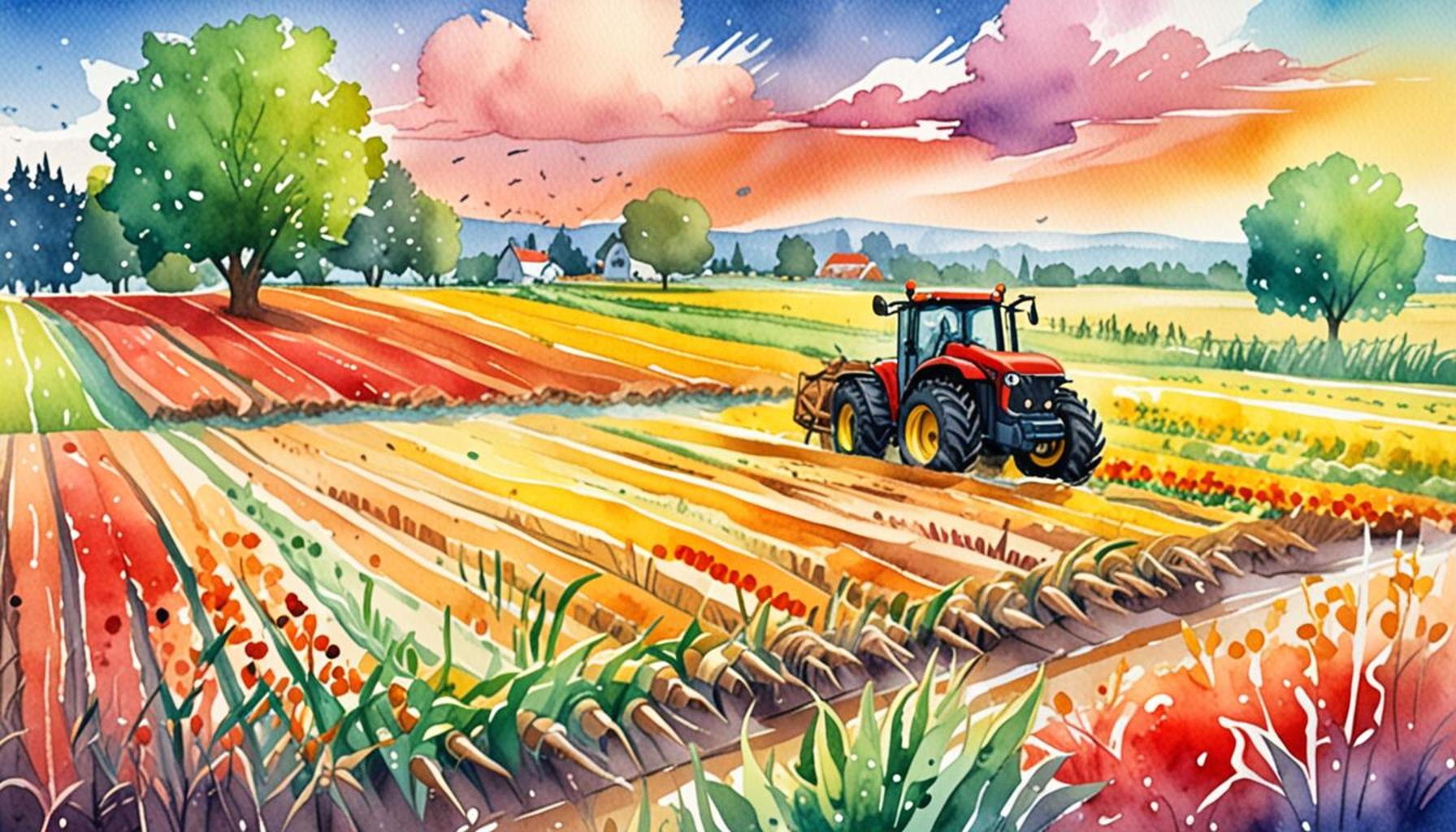How to Know the Right Time to Harvest Your Plants: Tips for Beginners

Understanding the Perfect Harvest Time
Knowing when to harvest your plants can make the difference between a bountiful harvest and mediocre produce. It’s not just about watching the calendar; several factors influence the timing. Below, we’ll explore key indicators to guide your harvesting decisions!
Key Indicators for Harvesting
- Color Change: Many fruits and vegetables change color as they ripen. For example, tomatoes transform from green to a vibrant red, indicating they are ready for picking. Similarly, a ripe banana shifts from green to yellow with brown spots, while peppers may change from green to red or yellow, depending on the variety.
- Firmness: A gentle squeeze can reveal if your produce is ready. Ripe cucumbers feel firm yet slightly yielding, and avocados should give a little under gentle pressure, suggesting they are ready to eat. If they are too hard, they may not be ripe enough, while excessive softness indicates overripeness.
- Size: Research the ideal sizes for your crops. For instance, bell peppers are typically harvested when they are about 3 to 4 inches in diameter. Likewise, zucchini can be picked when they are around 6 to 8 inches long, ensuring they develop in flavor without becoming overly tough.
In addition to these visual and tactile signs, it’s essential to consider the type of plant you’re dealing with. Each variety has its specific requirements. For example, knowing that some heirloom tomatoes have unique color patterns as they ripen can enhance harvesting accuracy. Similarly, understanding that certain melons like cantaloupes will easily slip from the vine when mature allows for a more effective harvest.
Timing and Environmental Factors
The season and location also play crucial roles in determining the optimal harvest time. Farmers and gardeners alike should be aware of the following:
- Weather Conditions: Harvesting during dry days is optimal for maintaining freshness. Rainy conditions can lead to waterlogged produce, affecting quality. For example, picking berries after a rain can result in bruising and spoilage.
- Day Length: Some plants prefer specific light conditions to reach peak ripeness. For instance, leafy greens often benefit from longer daylight hours to mature fully. In contrast, many root vegetables can be harvested early in the season when days are shorter, enhancing their sweetness.
By learning these fundamental concepts, you can enhance your gardening expertise and ensure your plants yield the best possible results. Engaging with local agricultural extension services or joining community gardening groups can also provide valuable insights into specific harvest times in your region, allowing for a more localized approach to gardening. As you delve deeper into these practices, you’ll find that the joy of harvesting only amplifies with knowledge and experience.

DISCOVER MORE: Click here for essential soil testing tips
Recognizing the Signs of Ripeness
Harvesting your crops at the right moment contributes significantly to the quality and flavor of your yield. As a beginner gardener, understanding the critical signs that indicate ripeness can truly transform your gardening experience. Here are some essential factors to help you recognize when your plants are ready to be harvested.
Visual Cues
- Total Maturity: Each plant species has its own growth stages, culminating in maturity—a phase where the produce showcases its full size and color. For instance, corn should be harvested when the husks are dry and the kernels are plump. A simple pinch can also help reveal if the kernels burst under pressure, indicating peak ripeness.
- Glossiness: Certain fruits, such as squash and eggplant, display a glossy surface when they are at their best. This sheen often signifies that the plant is still retaining adequate moisture, which contributes to the flavor and texture of the produce. Conversely, a dull appearance may suggest overripening.
- Seed Firmness: A keen observation of seed development can provide invaluable insight into harvest timing. For example, beans are generally picked when they are bulging in their pods, which reflects a healthy seed interior. However, waiting too long may lead to hard, dry seeds unsuitable for consumption.
Tactile Indicators
Beyond what you can see, exploring the texture and feel of produce is equally vital in understanding harvest readiness. Many gardeners underestimate the tactile approach, but it can be quite revealing:
- Touch and Feel: When harvesting fruits like cucumbers and melons, use your hands to gauge firmness. The texture can change significantly right before they reach maturity. A firm but slightly yielding feel on cucumbers suggests perfection, while very soft fruits indicate overripeness.
- Weight: For heavier produce such as pumpkins or watermelons, weight can be a significant indicator. When the fruit feels heavier than expected, it’s usually a sign that it has fully matured and is ready for harvest.
While these cues are generally consistent, it’s crucial to account for specific varieties within general categories. For instance, heirloom tomatoes might remain green with hints of yellow before they’re ripe, thus emphasizing the importance of researching the specific types of plants you are growing. Keeping a harvesting journal where you can note down key characteristics as the season progresses can also align your harvesting schedule more closely with optimal ripeness.
As you grow more experienced, identifying these signs will become second nature, enabling you to enjoy the fruits of your labor with confidence. Stay curious, and don’t hesitate to seek out community advice or further educational resources, as each harvest offers a new opportunity to learn and refine your gardening skills.
Understanding the Signs of Readiness
When it comes to harvesting, one of the crucial skills a gardener can develop is identifying the signs of readiness. Each plant has its own specific indications that signal it is ready to be picked. For instance, vegetables such as tomatoes will change color from green to a deep red or yellow, depending on the variety, while crops like corn will have firm kernels that release a milky juice when punctured. By observing these signs, beginners can maximize the quality and flavor of their harvest.
Use the Right Tools
Equipping yourself with the right tools not only simplifies the harvest but also helps protect the plants. Using a sharp garden knife or scissors ensures that you make clean cuts, minimizing damage to the plants and reducing the risk of disease. Additionally, having baskets or trays ready can help you collect your produce without bruising. Beginners should invest in quality tools designed for the purpose, as this can make a significant difference in both comfort and results.
Timing is Everything
Timing your harvest according to the right conditions further enhances the quality of your plants. Early morning is typically the best time, as this is when plants are most full of moisture and nutrients, resulting in better taste and longer shelf life. Moreover, paying attention to the weather is crucial; harvesting before a rainstorm can help prevent damage to your crops, while waiting too long can lead to overripeness.
| Sign of Readiness | Description |
|---|---|
| Color Change | Vegetables like peppers and tomatoes change their color when ripe. |
| Texture Firmness | Crops like cucumbers become firm to the touch when ready. |
Understanding these key aspects can position beginners for success in their gardening endeavors. By honing the ability to recognize the right time for harvesting, you will not only increase the yield but also enjoy the delicious fruits of your labor with greater satisfaction.
DIVE DEEPER: Click here for expert harvesting techniques
Timing Your Harvest: Beyond Signs of Ripeness
Knowing the right time to harvest doesn’t rely solely on visual and tactile cues; understanding the environmental and seasonal factors also plays a crucial role in determining the optimal moment for your plants. Timing can be influenced by weather conditions, the overall health of your plants, and even the specific growing practices unique to your garden. Here are some additional tips to ensure you harvest at the perfect moment.
Understanding Seasonal Timing
- Growing Seasons: Every plant has a specific growing season during which it reaches its peak maturity. For instance, tomatoes typically reach their prime during the late summer months. As a beginner, familiarize yourself with the growth timelines of the plants you are cultivating. Using planting calendars or local gardening resources can provide valuable insights into the best planting dates as well as the expected harvest timeframe.
- Frost Dates: In many regions, understanding the last frost date in spring and the first frost date in fall helps optimize your harvest. Plants like squash and cucumbers thrive in warm weather and need to mature well before the frost comes. Once temperatures begin to drop, it’s essential to harvest these crops to prevent damage. Keeping local weather forecasts in mind prepares you for any unexpected cold snaps.
Considering Plant Health and Size
The overall health of your plants is a deciding factor in harvesting; carefully assessing foliage and fruit condition can offer significant clues about when to pick. Here are a few health-related indicators:
- Leaf Color: Healthy green leaves are usually an indicator of well-nourished plants, but yellowing leaves may signify stress or nutrient deficiency. If your plants are exhibiting such signs, it may be beneficial to harvest your crops before they deteriorate further.
- Fruit Size and Shape: Consistency in size and shape among your produce is a sign of healthy growth. For example, bell peppers should be a consistent size, and any irregularities might suggest stress in the plant. Measure the growth by comparing fruits in their clusters to identify the correct harvest window quickly.
Timing Your Harvest for Enhanced Flavor
In addition to visual and tactile signs, harvesting at precise times of day can also greatly affect the flavor of your produce. Understanding this can make a notable difference in the taste:
- Morning Harvest: Many gardeners recommend harvesting in the early morning before the sun becomes too intense. During this time, plant sugars are at their peak, resulting in sweeter fruits and vegetables. For crops like tomatoes, the early morning advantage can significantly enhance their flavor profile.
- Avoiding Rainy Days: If your plants are particularly wet from rain, it can dilute the flavors of fruits and vegetables, potentially affecting their overall quality. Harvesting after a dry spell can ensure that your produce retains its vibrant taste.
As you delve deeper into your gardening journey, consider experimenting with these various factors affecting harvest time. Each season presents a unique opportunity to refine your skills and enjoy distinct flavors and qualities from your garden. Collaborating with local gardening communities and attending workshops can enrich your understanding of plant growth cycles and empower you to become an even more adept gardener.
DISCOVER MORE: Click here to enhance your gardening skills
Conclusion: Mastering the Art of Harvesting
In conclusion, knowing the right time to harvest your plants is an essential skill that takes observation, practice, and an understanding of both plant biology and environmental conditions. As a beginner gardener, integrating the knowledge of visual cues, seasonal timing, plant health, and even the ideal moments to harvest throughout the day can pave the way for a successful gardening experience. Always remember that each plant has its unique timeline and characteristics, making it crucial to cultivate an awareness specific to your garden.
Moreover, staying informed about local weather patterns, frost dates, and utilizing tools such as planting calendars can enhance your harvesting strategy. Engaging with local gardening communities can offer additional insights and experiences that contribute to your knowledge base, allowing you to optimize your harvesting skills even further.
Ultimately, your efforts in mastering the timing of your harvest will not only improve the quality and flavor of your harvest but will also lead to a fulfilling gardening journey. As the seasons change and your understanding deepens, you might find yourself developing a keen intuition about when to harvest, setting you on a path towards producing delicious and vibrant crops. So grab your basket, embrace the learning process, and harvest the rewards of your labor in your own backyard garden!


